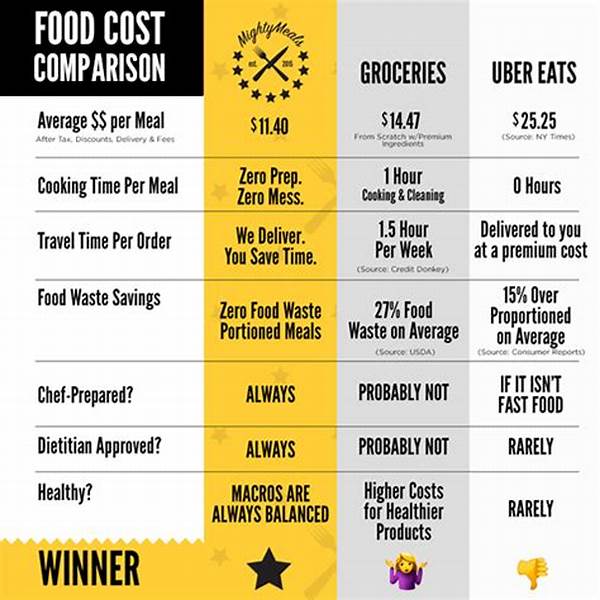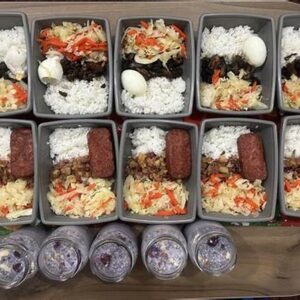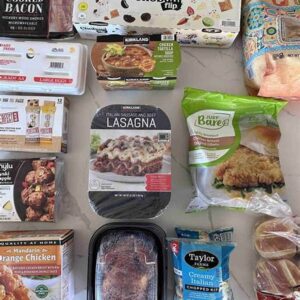When it comes to feeding oneself in Indonesian cities, a pivotal question arises: to prepare meals at home or to order them in? The answer seems simple enough, but it is cloaked in layers of not just pricing, but convenience, time, health considerations, and personal preferences. Welcome to the delightful maze of meal prep vs order food: cost analysis in Indonesian cities, where the decisions go far beyond the contents of your wallet.
Read More : How To Prep Smoothies For Gym-goers
Imagine the bustling streets of Jakarta, where the aroma of street food entices you at every corner. Here, the allure of convenience is hard to resist. You can savor a variety of flavors ranging from spicy Padang cuisine to sweet and rich Martabak without ever turning on an oven or stove. The economics of ordering food play a critical role; what’s interesting is that while street food and simple eateries might offer affordability, frequent orders from higher-end services like GoFood or GrabFood could sneakily add up over time.
Now, picture someone standing in a grocery store aisle in Surabaya, contemplating the raw ingredients that could potentially transform into delicious home-cooked meals. The idea of meal prep calls to those who not only wish for healthier dining options but also aim to stretch their rupiah further. Meal prepping means buying in bulk, utilizing each ingredient to its fullest potential, and mastering the balance between cost and quantity.
But who wins the cost battle in the greater landscape of meal prep vs order food: cost analysis in Indonesian cities? It is not merely about numbers; it’s a narrative of modern Indonesian life, rich with flavors and diverse consumer behaviors. Whether shared among roommates or savored solo, each decision carries economic implications that deserve thoughtful consideration.
The Economics of Meal Prepping
It’s enamoring to consider meal prepping from an economical perspective. In cities like Yogyakarta, where the pace is both leisurely and lively, shopping from traditional markets could provide significant savings. Residents have the luxury of time to soak beans overnight or slowly cook rendang in a clay pot – luxuries seemingly unattainable for busy professionals.
Meal prepping requires a strategic mindset. Here, bulk buying becomes a form of artistry, not just a shopping strategy. A savvy meal prepper may find joy in crafting meal plans that interlace ingredients like tofu and tempeh across multiple dishes, decreasing waste and maximizing nutrition.
In our bustling Indonesian cities, even amid a cultural mosaic, meal prep practitioners often share the sentiment that every saved rupiah is money accumulated for future feasts, travels, or even personal savings. Such is the allure of meal prep when viewed through the kaleidoscope of budgeting and creativity.
—
Introduction to Meal Prep vs Order Food: Cost Analysis in Indonesian Cities
In the extensive archipelago of Indonesia, a land rich in culinary traditions and diverse economies, the choice between meal preparation and ordering food is an intriguing conundrum. At first glance, this appears merely as a daily dietary decision. Yet, on closer inspection, it embodies a tapestry of socioeconomic influences, personal lifestyle choices, and regional disparities. Welcome to the exploration of meal prep vs order food: cost analysis in Indonesian cities.
When diving into the motives behind meal prep versus ordering food, it becomes clear that personal stories and testimonials offer valuable insights. The urban young professionals of Bandung, for example, share anecdotes of late-night nasi goreng runs, interspersed with attempts at healthy meal preparation on Sundays. For these busy bees, the decision often leans upon temporal convenience versus nutritional aspirations.
In contrasting shifts, students in cultural hubs like Yogyakarta weigh practicality. On the one hand, the allure of street food offers a gastronomical adventure without any dishes to wash. On the other hand, learning the ropes of economical cooking encourages both thriftiness and culinary skill—a rite of passage in student life.
Meanwhile, the broader economic analysis unveils intriguing patterns. Jakarta, with its sprawling foodie scene, offers opportunities and temptations aplenty. Yet, behind every tempting plate of soto Betawi lies a running calculator of weekly dining expenditures, occasionally tipping in favor of planned home-cooked meals. The evolution of digital platforms like Tokopedia and Bukalapak even empowers consumers to compare costs of ingredients accurately.
Central to this dialogue is understanding that the solution doesn’t lie in a ‘one-size-fits-all’ paradigm. Every decision, nuanced with factors like commute duration, kitchen space, or dietary needs, tells its own tale in the anthology that is meal prep vs order food: cost analysis in Indonesian cities.
So, what’s in store for the future? As millennials and Gen Zs shape tomorrow, their choices will undoubtedly redefine dining paradigms. The rise of sustainable practices, coupled with a surge in eco-friendly packaging, might sway decisions towards greener meal prepping. Alternatively, tech-savvy ordering platforms promise revolutionary experiences, from AI-driven recommendations to seamless cashless transactions.
Future Perspectives on Eating Trends in Indonesian Cities
The future is replete with possibilities, as varied as the flavor of sambal across regions. Predicted trends hint at a blend of tradition meeting technology. As virtual reality dining experiences emerge—dinner in Bali from your Jakarta apartment, anyone?—the question emerges again: does this advance meal prep or food orders?
In closing, let us cherish the colorful mosaic of Indonesian dining options. This journey, punctuated with questions of economy, lifestyle, and cultural tradition, continues to evolve. Whether you’re a staunch supporter of hand-cut tempeh or a loyal follower of the Gojek army, meal prep vs order food: cost analysis in Indonesian cities remains an endlessly fascinating tale.
—
Related Topics
—
In a world where every minute counts and culture meets commerce, the debate between meal prep and ordering food takes center stage. In intriguing discussions across spaces from upscale co-working cafes in Jakarta to community forums in Medan, locals share insights and statistical revelations that enrich the conversational tapestry. Meal prep vs order food: cost analysis in Indonesian cities is a phenomenon just aching for deeper investigation.
The juxtaposition of meal prep and ordering lends itself to statistical exploration. For instance, a study might reveal that freelance professionals in Malang spend an average of 25% less on meals when prepping their own food compared to ordering. Meanwhile, conversations buzz with testimony from street food lovers, who eagerly defend their choices based on flavor diversity and local dining camaraderie.
Navigating these exchanges allows for an exhilarating display of both rational decision-making and emotional indulgence. Parents in bustling Surabaya might recount the joy of baking cookies at home with their kids—more cost-effective and undeniably heartwarming. At the same time, young professionals might argue for preserving their precious few hours post-work by ordering in nasi campur from their favorite local warung.
Ultimately, food isn’t just sustenance; it’s a social currency intertwined with identity and experience. As cities evolve and global influences seep in, Indonesians adjust, harmonizing modern conveniences with cherished traditions. And so, the vibrant tapestry of meal prep versus order food in Indonesian cities unfolds, a story that invites you to take part.
—
Meal Prep vs Order Food: A Comparative Evaluation
The notion of meal prep versus food ordering in Indonesian cities encompasses a multitude of considerations beyond mere financials. This narrative weaves through lifestyle adaptations, cultural preferences, as well as economic variations. Its intrigue is found in the balance between fast-paced urban existence and resilient cultural traditions.
Meal prepping, often hailed for its cost efficiency and health benefits, requires commitment. Yet, this commitment often pays dividends in unexpected ways. Consider Reza, a digital nomad in Bali, who swears by his Sunday ritual of preparing meals for the week. He feels this regimen not only fortifies his budget but fuels his creative spirit as he embarks on weekly culinary experiments. Such testimonials amplify the appeal of meal prep for many hardworking Indonesians making conscious lifestyle choices.
Contrastingly, food ordering exemplifies convenience universally cherished by many. Imagine Wina, a new graduate in Jakarta, reveling in the convenience of ordering her favorite ayam geprek with the swipe of a finger during a busy workday. Her testimonial attests to food delivery services successfully bridging the gap between consumer desire and timely satisfaction.
Yet, each choice carries its repercussions. The cumulative cost of routine orders may gradually eclipse grocery budgets earmarked for a week’s worth of homemade meals. Here lies the crux of meal prep vs order food: cost analysis in Indonesian cities. Each decision, weighed upon convenience scales, draws contrasts often startling to those unaccustomed to scrutinizing spending habits.
Indonesia’s digital landscape lends a fascinating angle to this ongoing saga. App developers innovate relentlessly, enriching user experiences with sophisticated algorithms tailored to individual preferences. This captivates a tech-savvy audience always ready for digital bests in food ordering—an evolution deserving of applause or critique in its environmental impact.
In closing this exploration, what remains is the knowledge that neither choice is superior by an objective measure. Instead, each person must chart their path through the culinary options, carving out personal connections with food that speak to budgetary prudence, joyful indulgence, or somewhere in between—a nuanced dance of modern life.




